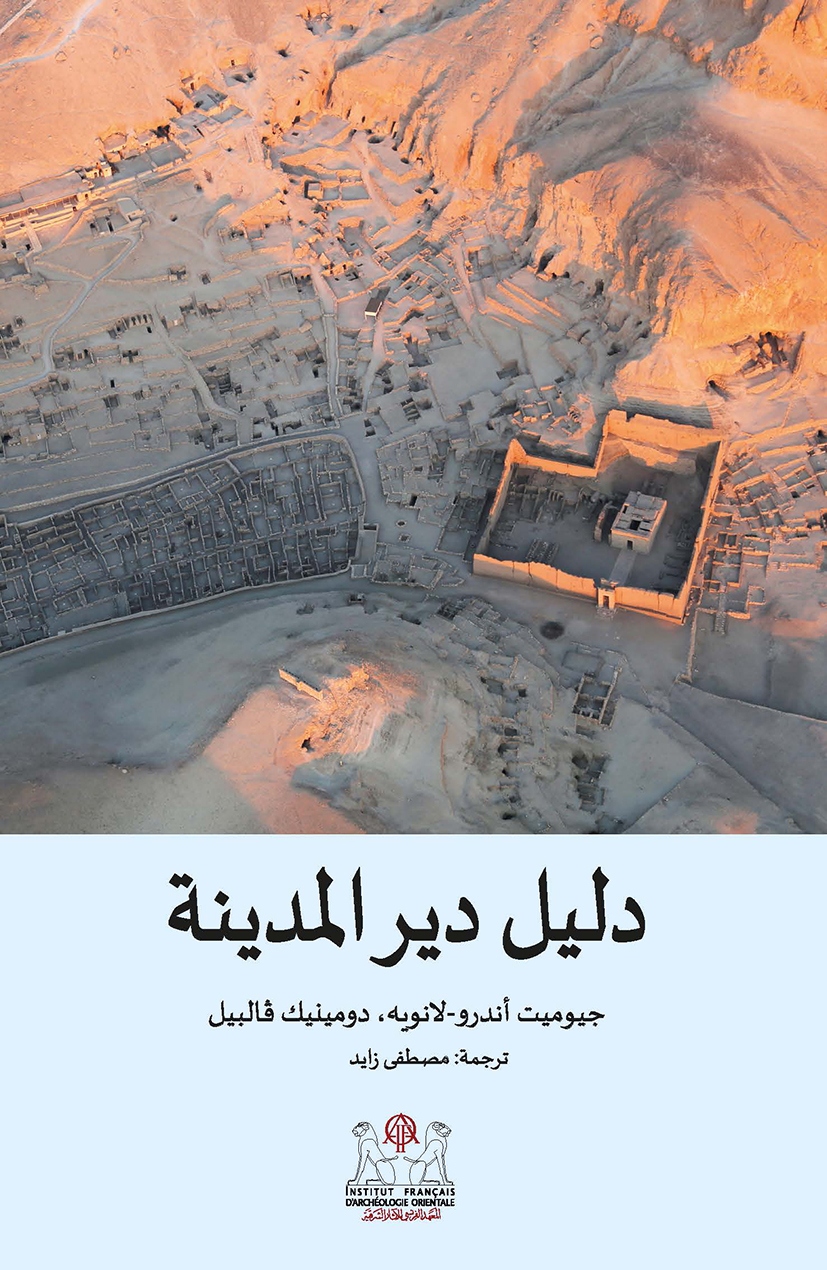Catalogue des publications
- Pour effectuer une commande, remplissez votre panier puis terminez votre commande. Vous pourrez effectuer un paiement sécurisé et être livré dans le monde entier. J’ai un code promotionnel
- To perform an order, fill your cart then proceed the order. You will be driven to a secured page for the electronic payment which includes worldwide shipping fees. I have a promotional code.
Guides de l'Institut français d'archéologie orientale (GIFAO)
Les Guides de l’Ifao » (GIFAO) se déclinent en deux séries :
- Les Guides de sites archéologiques proposent au visiteur un itinéraire commenté et documenté, richement illustré, de l’un des sites majeurs de l’Égypte ;
- Les Guides thématiques explorent de manière transversale et synthétique une notion ou un concept clé de la civilisation égyptienne, en s'appuyant sur une riche iconographie.
Rédigés par des spécialistes affiliés à l’Ifao, les guides donnent au curieux, à l’amateur éclairé ou au passionné d’égyptologie, les clés de compréhension d’une civilisation aussi exceptionnelle que fascinante.
Guillemette Andreu-Lanoë, Dominique Valbelle
دليل دير المدينة
يُعَدُّ موقع دير المدينة فريدًا من نوعه؛ حيث تُشَكِّل أطلاله الأثرية، المحفوظة جيدًا، مجموعة استثنائية في مصر (حيث تتكون من قرية وجَبَّانة ومعبد)، كما تمتد الوثائق الغنية التي تركها إلى آلاف السنين. كان سكان دير المدينة فنانين وحرفيين في آن واحد، قاموا بحفر وزخرفة مقابر الملوك المحفورة في الصخر في وادييّ الملوك والملكات. وهم لم يكتفوا بإظهار مواهبهم لصالح الملوك فحسب، بل قاموا أيضًا بتزيين مقابرهم، أو جعلوا مَنْ هم أكثرهم مهارة يزينون مقابرهم الخاصة، ودفنوا مئات من الأشياء المتصلة بالطقوس والأثاث الجنائزي. وكان الكتبة يحتفظون بأرﺷﻴﭭﺎت تُشكل ثروة مدهشة من المعلومات عن تاريخ الدولة الحديثة وعن سير عمل مواقع البناء الملكية؛ كما كانت لديهم اهتمامات أدبية، وقام بعضهم بتشكيل مكتبات من أغنى ما وصل إلينا. حسبما يتجول الزائر في موقع دير المدينة، ومن خلال اللوحات التي تزين جدران الأقبية الصخرية، سيتمكن من اكتشاف روح ساكنيها وتطلعاتهم الدنيوية، والعالم الديني والجنائزي لتصورهم عن العالم الآخر، واحتفالات الآلهة العديدة التي تؤَلِّف مَجْمَع الآلهة المحلية. ويُشَكِّل استكشاف المعبد الذي بُنِيَّ في العصر البطلمي خاتمة سعيدة لهذه الجولة الأثرية. قام بالترجمة من الفرنسية إلى العربية مصطفى زايد.
Le site de Deir el-Médina est unique : ses vestiges archéologiques, particulièrement bien préservés, forment un ensemble exceptionnel en Égypte (constitué d’un village, d’une nécropole et d’un temple), et la riche documentation qu’il a livrée a traversé les millénaires.
Artistes autant qu’artisans, les habitants de Deir el-Médina creusaient et décoraient les hypogées des souverains dans la Vallée des Rois et des Reines. Ils ne se limitaient pas à exercer leurs talents au bénéfice des souverains, ils ont aussi décoré, ou fait décorer par les plus habiles d’entre eux, leurs propres sépultures et se sont fait enterrer avec des centaines d’objets de culte et de mobilier funéraire. Les scribes tenaient des archives, qui constituent une incroyable mine d’informations sur l’histoire du Nouvel Empire et le fonctionnement des chantiers royaux, mais ils avaient aussi des intérêts littéraires, et certains ont constitué des bibliothèques parmi les plus riches qui nous sont parvenues.
Au gré de sa promenade sur le site de Deir el-Médina et à travers les peintures qui ornent les parois des caveaux rupestres, le visiteur pourra découvrir l’esprit de ses occupants, leurs aspirations terrestres, l'univers religieux et funéraire de leur conception de l’au-delà et les fêtes des multiples divinités qui composaient le panthéon local. La découverte du temple, élevé à l’époque ptolémaïque, constitue un épilogue heureux à cette promenade archéologique.
Traduit du français en arabe par Mostafa Zayed.
The site of Deir el-Medina is unique in its particularly well-preserved archaeological remains, which represent an exceptional ensemble in Egypt (consisting of a village, a necropolis and a temple), and in the rich documentation that it has delivered across the millennia.
The inhabitants of Deir el-Medina—artists as well as craftsmen—dug and decorated the hypogea of the sovereigns in the Valley of the Kings and Queens. They did not restrict the use of their talents to the only benefit of the sovereigns, but decorated, or had decorated by the most skilled amongst them, their own tombs and were buried with hundreds of cult objects and grave goods. The scribes kept archives, which constitute an incredible wealth of information for the history of the New Kingdom and the functioning of the royal sites. They also had literary interests, and some of them established libraries, which are considered among the richest of those that have survived.
Walking around the site of Deir el-Medina and studying the paintings that adorn the walls of the rock tombs, the visitor will get to know the spirit of its occupants, their earthly ambitions, the religious and funerary universe of their conception of the afterlife and also the feasts of the multiple deities who composed the local pantheon. Coming upon the temple, built in the Ptolemaic period, comes as a perfect ending to this archaeological walk.
Translated from French to Arabic by Mostafa Zayed.
- Guillemette Andreu-Lanoë (
: 029120497)
Ancien membre scientifique de l’IFAO, Guillemette Andreu-Lanoë a été conservatrice puis directrice du département des Antiquités égyptiennes du Louvre. Spécialiste de Deir el-Médina, elle a consacré en 2002 une exposition internationale (Paris, Turin, Bruxelles) aux artistes et artisans de Deir el-Médina. - Dominique Valbelle (
: 027174107)
Ancien membre scientifique de l’Ifao, professeur émérite de Sorbonne-Université, Dominique Valbelle a consacré de nombreuses années au site de Deir el-Médina. Elle a rédigé une synthèse sur l’institution et les hommes de « la Tombe » et publié plusieurs volumes sur les ouchebtis, les poids à inscriptions hiératiques, une tombe et les registres de recensement dans le Village.
- Vous pouvez acquérir ce(s) fichier(s) PDF issu(s) de cet ouvrage en cliquant sur le nom du fichier puis 'Ajouter au panier'.
- You can buy theses PDF files extracted from this book by clicking on the file name then 'Add to cart'.


